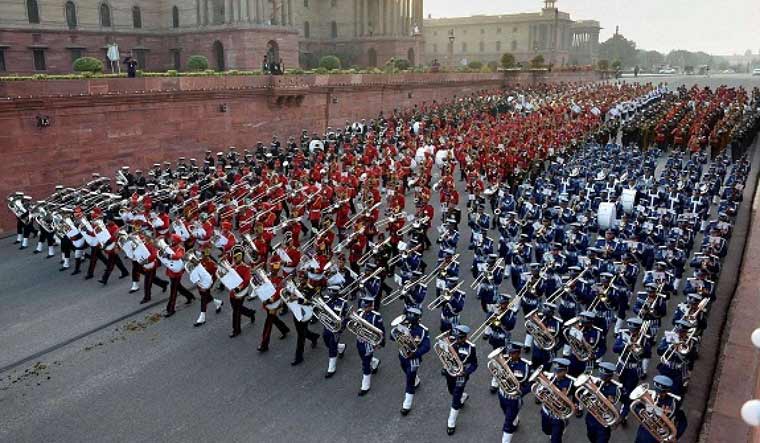After facing criticism from various quarters, the defence ministry has included the hymn Abide With Me in the upcoming Beating Retreat ceremony. Earlier, the defence ministry had decided to replace it with the national song, Vande Mataram, as last tune of the event, in an attempt to “Indianise” the ceremony.
Vande Mataram will also be played as the latest inclusion.
Written by Scottish poet Henry Francis Lyte and composed by William Henry Monk, the hymn has become part of the Beating Retreat ceremony after the Mysore palace band was invited to perform in the Republic Day celebrations of 1950. The popular hymn was also a favourite of Mahatma Gandhi and is played in the Sabarmati Ashram every morning, along with his other favourites like Vaishnav Jan Toh, Raghupati Raghav Raja Ram and Lead Kindly Light.
"Yes, Abide With Me will be played in the ceremony. The national song, Vande Mataram will also be played by the band," an official said.
Beating Retreat, a 45-minute martial music ceremony, is held on January 29 to mark the end of the Republic Day celebrations. The tradition dates back to ancient times—a call or signal sent out at sunset to patrollers and troops at war, telling them to return to base. During the ceremony, Abide With Me was played just before the national flag was lowered at dusk.
For the first time on Republic Day, this year, wreath-laying will be held at the newly constructed National War Memorial instead of the four decade-old Amar Jawan Jyoti (flame of the immortal solider) at India Gate.
also read
- India celebrates 76th Republic Day today; PM Modi, President Murmu lead fete
- 'One Nation One Poll' can promote consistency in governance, reduce financial burden: President Murmu
- Who is Raman Rajamannan, the tribal king from Kerala invited to attend Republic Day celebrations in Delhi
- Andhra Pradesh’s Republic Day tableau to highlight unique traditional toys
- Why hasn't India announced Indonesian President Prabowo Subianto's visit for Republic Day event yet
Amar Jawan Jyoti was constructed after India's victory over Pakistan in 1971 to honour the 3,843 soldiers who died in the war. Though the memorial was constructed in December 1971, it was formally inaugurated by former prime minister Indira Gandhi on January 26, 1972. Since then, every year on the Republic Day, it has been customary for the president, prime minister, chiefs of the Army, Navy and IAF, and other dignitaries to place a wreath at Amar Jawan Jyoti and pay homage to the fallen soldiers before the parade. Moreover, visiting foreign dignitaries, especially defence ministers or chiefs of armed forces, begin their official engagements after a visit to the memorial as a mark of respect to the martyrs.
Beating Retreat ceremony at Vijay Chowk traces its origin to the visit of Queen Elizabeth II and Prince Philip in 1961, on the behest of the then prime minister Jawaharlal Nehru. Major G.A. Roberts from the Grenadiers battalions of Indian Army conceived the grand show.
The hymn is often sung at Christian funerals and was played onboard the Titanic just before it sank. During World War I, British nurse Edith Cavell sang it the night before she was shot for helping British soldiers escape Germany-occupied Belgium. It is a favourite of the British royal family and also features in Hollywood movies such as The Full Monty and A Bridge Too Far. Former president Shankar Dayal Sharma was once moved to tears when he heard it at the ceremony.
In military tradition, the main objective of martial tunes is to promote orderly marching, enliven the spirit, and minimise fatigue and boredom. They also inspire troops to fight and carry out orders and commands.
According to documents available with the Indian Army's military music wing, Pachmarhi in Madhya Pradesh, the Indianisation of martial music actually began with Dr Herold Joseph, who was an officer on special duty, military music, ministry of defence, for more than a decade. He broke new grounds by composing a number of quick march tunes based on Indian folk melodies. Later, some tunes were based on ragas. Indian musical instruments such as santoor, sitar, bamboo flute, tabla and dholak have also found a place in band concerts. But, not in military parade.
After Independence, British bandsmen were repatriated, thereby creating a void. But soon, Indian musicians proved adept at carrying on the western traditions of military music.
Historically, military bands were first acknowledged in 17th century, when music-loving warriors like Louis XIV (1643-1715) and Frederick the Great (1770-86) encouraged military bands. French and English armies formed regimental bands consisting only of woodwinds (oboe and bassoon). Brass instruments were added to the woodwinds in the 18th century. Soon, cymbals, bells, triangles and bass drums were added to the wind and brass of the European army.
Bagpipes were adopted by Irish and Scottish military in 16th century. Trumpets and drums were used by Mughals armies in India in the 18th century. Military bands were invited to give public performances during Napolean's rule. "In the late 18th and 19th century, the advent of mass armies gave rise to patriotic war songs, of which La Marseillaise of revolutionary France was the prototype. The American Civil War songs, such as The Battle Cry of Freedom, lifted the spirit of Union soldiers on the march and the combat," records of the military music wing say.
“Though the military band is ceremonial in its functions, it plays an important role in instilling a sense of pride and motivating the men to accomplish deeds of excellence, be it in operations, the field of sports or other functions of regimental life,” said an Army officer.



